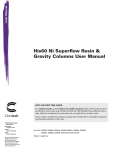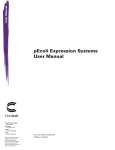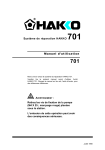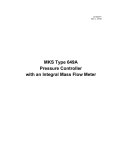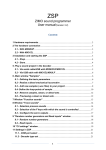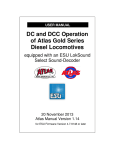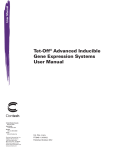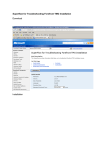Download His60 Ni Superflow Cartridges User Manual
Transcript
Clontech Laboratories, Inc. His60 Ni Superflow Cartridges User Manual PT5143-1 Cat. No(s). 635674, 635675, 635678, 635679, 635680 (030212) Clontech Laboratories, Inc. A Takara Bio Company 1290 Terra Bella Avenue, Mountain View, CA 94043, USA U.S. Technical Support: [email protected] United States/Canada 800.662.2566 Asia Pacific +1.650.919.7300 Europe +33.(0)1.3904.6880 Japan +81.(0)77.543.6116 His60 Ni Superflow Cartridges User Manual Table of Contents I. Introduction ..................................................................................................................................................................... 3 A. His60 Ni Superflow 1 ml & 5 ml Cartridge Specifications ........................................................................................ 3 B. His60 Ni Superflow Resin .......................................................................................................................................... 4 II. List of Components ......................................................................................................................................................... 6 III. Additional Materials Required .................................................................................................................................... 7 A. Equipment ................................................................................................................................................................... 7 B. Buffers – Native Conditions ....................................................................................................................................... 7 C. Buffers – Denaturing Conditions – Guanidine-HCl or Urea....................................................................................... 8 D. Enzymes ...................................................................................................................................................................... 8 E. Accessories for Automated Purification ..................................................................................................................... 8 F. Accessories for Syringe-Based Purification................................................................................................................ 8 G. Optional....................................................................................................................................................................... 8 IV. V. Related Products: Extraction Buffers, Protease Inhibitors, and His-Tag Antibodies ................................................. 9 Sample Preparation & Purification ............................................................................................................................... 10 A. PROTOCOL: Extracting Proteins from Cells ........................................................................................................... 10 B. PROTOCOL: Automated Purification on a Liquid Chromatography System .......................................................... 11 C. PROTOCOL: Manual Purification Using a Syringe ................................................................................................. 12 D. PROTOCOL: Complete Regeneration of His60 Ni Superflow Cartridges ............................................................... 14 VI. Troubleshooting Guide ............................................................................................................................................. 15 Table of Tables Table 1. His60 Ni Superflow Cartridge Specifications ........................................................................................................... 3 Table 2. Reagent Compatibility with His60 Ni Superflow Resin (Based on Literature References) ..................................... 5 Table 3. Troubleshooting Guide for His60 Ni Superflow Cartridges ................................................................................... 15 PT5143-1 030212 www.clontech.com Clontech Laboratories, Inc. A Takara Bio Company Page 2 of 15 His60 Ni Superflow Cartridges User Manual I. Introduction Clontech’s His60 Ni Superflow Cartridges are prefilled with 1 ml or 5 ml of His60 Ni Superflow resin and are ready to use for purification of his-tagged proteins using a syringe, peristaltic pump, or liquid chromatography systems such as ÄKTA or other FPLC systems. A. His60 Ni Superflow 1 ml & 5 ml Cartridge Specifications Table 1. His60 Ni Superflow Cartridge Specifications 1 ml Cartridge Support 5 ml Cartridge Superflow 6 (cross-linked agarose) 60–160 μm Bead diameter Column dimensions (mm i.d.) 0.7 cm x 2.5 cm Maximum pressure1 Typical back pressure Recommended flow rate Maximum flow rate2 1.6 cm x 2.5 cm 5 bar, 0.5 MPa 1.0 bar, 0.1 MPa (1 ml/min) 2.0 bar, 0.2 MPa (5 ml/min) 1 ml/min (156 cm/hr) 5 ml/min (149 cm/hr) 10 ml/min (1,559 cm/hr) 40 ml/min (1,193 cm/hr) pH stability short term (≤2 hr) 2–14 pH stability long term (>2 hr) 3–14 Binding capacity3 System compatibility4 Cartridge body material Connectors 60 mg of AcGFPuv 300 mg of AcGFPuv Automated chromatography systems (e.g., ÄKTA, FPLC, etc.), peristaltic pump or syringe Polypropylene 1/16” (inlet); 1/16” (outlet) 1 The maximum pressure that can be used with the Superflow matrix itself is 10 bar. However, stability of the cartridges is only guaranteed up to 5 bar. 2 High flow rates may lead to reduced recovery of 6xHis-tagged protein. 3 Binding capacity may vary from protein to protein. 4 Adaptors may be necessary. PT5143-1 030212 www.clontech.com Clontech Laboratories, Inc. A Takara Bio Company Page 3 of 15 His60 Ni Superflow Cartridges User Manual B. His60 Ni Superflow Resin Clontech’s His60 Ni Superflow Resin is a high-capacity Ni-IDA resin that has been optimized for the efficient one-step purification of expressed his-tagged proteins from bacterial, yeast, mammalian, and baculovirus-infected cells. The combination of the high density of nickel (II) ion and the high flow rates of the Superflow 6 agarose beads allow the efficient capture of target his-tagged proteins. Up to 60 mg of his-tagged protein can be adsorbed onto 1 ml of His60 Ni resin (data based on purification of AcGFP1). The His60 Ni Superflow Cartridge Purification Kit (5 x 1 ml) provides 5 prepacked His60 Ni Superflow Cartridges (each containing 1 ml of resin), as well as all the buffers needed for protein extraction and purification (also available separately as the His60 Ni Buffer Set)—see Section II. The His60 Ni Cartridge Purification Kit (5 x 5 ml) provides 5 prepacked His60 Ni Superflow Cartridges (each containing 5 ml of resin), as well as all the buffers needed for protein extraction and purification (also available separately as the His60 Ni Buffer Set)—see Section II. Limitations of His60 Ni Superflow Resin Please note the following recommendations when using His60 Ni Superflow Cartridges: Do not use chelator-containing protease inhibitors or other additives, EDTA, or strong reducing agents (see Table 2 and the note below regarding the use of reducing agents). For automated liquid-chromatography (LC) applications, use highly pure, low-absorbance imidazole (Fisher, Product No. BP 305-50). Always filter buffers through a 0.45 μm filter and degas before use. His60 Ni allows protein purification under either native or denaturing conditions. The resin is compatible with multiple denaturants and detergents (Table 2). NOTE: Using βME as a reducing agent with His60 Ni Superflow Resin sharply reduces protein yield. If high levels of βME are required for purification, we strongly recommend using TALON resin, which provides high yields of the target protein in up to 30 mM βME. PT5143-1 030212 www.clontech.com Clontech Laboratories, Inc. A Takara Bio Company Page 4 of 15 His60 Ni Superflow Cartridges User Manual Table 2. Reagent Compatibility with His60 Ni Superflow Resin (Based on Literature References) Reagent Amino Acids Arginine, Glycine, Glutamine Histidine Buffers HEPES, MOPS Sodium acetate Sodium phosphate Tris Chelating Agents EDTA, EGTA Denaturing Agents Gu-HCl Urea Detergents1 CHAPS NP-40 SDS Triton X-100 Tween 20 Reducing Agents ßME DTT Notes Acceptable Concentrations Not recommended Binds to His60 Ni and competes with histidine residues in the his-tag. Amine groups that are present in these buffers can interact with Ni2+ ions, diminishing the resin’s binding capacity. Coordinates weakly with metal ions, causing a decrease in binding capacity. Up to 100 mM (with caution) Up to 100 mM (with caution) Up to 50 mM can be used Up to 50 mM (with caution). Loss in binding capacity can be seen. Will strip metal ions from the resin, resulting in protein elution and a resin color change. Not recommended With high concentrations, protein unfolding generally takes place. Protein refolding on-column (or after elution) is proteindependent. With high concentrations, protein unfolding generally takes place. Protein refolding on-column (or after elution) is proteindependent 6M Ionic detergents such as CHAPS, SDS, and sarkosyl are compatible at concentrations up to 1%. Even at low concentrations you should expect interference with binding. Has high absorbance at 280 nm. Ionic detergents such as CHAPS, SDS, and sarkosyl are compatible at concentrations up to 1%. Even at low concentrations you should expect interference with binding. Has high absorbance at 280 nm. Use the resin immediately after equilibrating with buffers containing βME. Otherwise the resin will change color. Do not store the resin in buffers containing βME. A slight change in color (yellowing of the resin) will occur. Since DTT is a reducing agent, low concentrations will reduce the metal ions in His60 Ni Superflow resin. Although enough of these ions may remain unaffected to allow protein purification, please use it with caution. Do at least 20 column volumes of washes, preferably with low concentrations of imidazole (40 mM) to wash out any reduced metal ions. DTE Others MgCl2 CaCl2 Ethanol May precipitate proteins, causing low yields & column clogging. Glycerol 1 Detergents cannot be easily removed by buffer exchange. PT5143-1 030212 Can be used at low concentrations (20 mM) to inhibit nonspecific binding; and, at a higher concentration (up to 100 mM), to elute his-tagged proteins www.clontech.com Clontech Laboratories, Inc. A Takara Bio Company 8M 1% (with caution) 2% 1% (with caution) 1% 2% 20 mM (with caution) 1 mM (with caution) Not recommended 4M 5 mM 20% 20% Page 5 of 15 His60 Ni Superflow Cartridges User Manual II. List of Components Store all components at 4oC. His60 Ni Superflow Cartridges (5 x 1 ml) (Cat. No. 635675) 5 His60 Ni Superflow Cartridges (1 ml each) 5 Top Caps 5 Snap-Off End Caps His60 Ni Buffer Set (Cat. No. 635665) 2 x 250 ml His60 Ni Equilibration Buffer 1 x 200 ml His60 Ni Elution Buffer 1 x 100 ml His60 Ni xTractor Buffer NOTE: His60 Ni xTractor Buffer is equivalent to the xTractor Buffer supplied in Cat. Nos. 635623, 635625, 635656 & 635671 (see Section IV). His60 Ni Superflow Cartridge Purification Kit (5 x 1 ml) (Cat. No. 635674) 1 His60 Ni Superflow Cartridges (5 x 1 ml) (Cat. No. 635675) 1 His60 Ni Buffer Set (Cat. No. 635665) His60 Ni Superflow Cartridge (1 x 5 ml) (Cat. No. 635680) 1 His60 Ni Superflow Cartridge (5 ml each) 1 Top Cap 1 Snap-Off End Cap His60 Ni Superflow Cartridges (5 x 5 ml) (Cat. No. 635679) 5 His60 Ni Superflow Cartridges (5 ml each) 5 Top Caps 5 Snap-Off End Caps His60 Ni Superflow Cartridge Purification Kit (5 x 5 ml) (Cat. No. 635678) 1 His60 Ni Superflow Cartridges (5 x 5 ml) (Cat. No. 635679) 1 His60 Ni Buffer Set (Cat. No. 635665) PT5143-1 030212 www.clontech.com Clontech Laboratories, Inc. A Takara Bio Company Page 6 of 15 His60 Ni Superflow Cartridges User Manual III. Additional Materials Required A. Equipment For His60 Ni Superflow Cartridges, you will need the following equipment: A suitable liquid chromatography system (LC procedure only) such as ÄKTA or other systems A syringe or manual pump NOTE: For best results, process all buffers through a 0.45 μm filter and degas before use in LC applications. B. Buffers – Native Conditions For your convenience, we provide a separate kit containing a set of His60 Ni Extraction, Equilibration, and Elution Buffers, the His60 Ni Buffer Set (Cat. No.635665), which is sufficient for approximately 20 purifications on 1 ml His60 Ni Superflow Cartridges (5 x 1 ml) (Cat. No.635675), or 5 purifications on 5 ml His60 Ni Superflow Cartridges (5 x 5 ml) (Cat. No. 635679). The His60 Ni Buffer Set is also available together with the 1 ml cartridges in the His60 Ni Superflow Cartridge Purification Kit (5 x 1 ml) (Cat. No. 635674), and together with the 5 ml cartridges in the His60 Ni Superflow Cartridge Purification Kit (5 x 5 ml) (Cat. No. 635678)—see Section II. The following information is provided if you wish to prepare your own buffers for use with other applications. Please note that for FPLC and other automated applications, you need to filter the buffers through a 0.45 μm filter and degas them before use. Equilibration Buffer: 50 mM sodium phosphate, 300 mM sodium chloride, 20 mM imidazole; pH 7.4 Wash Buffer: 50 mM sodium phosphate, 300 mM sodium chloride, 40 mM imidazole; pH 7.4 –– Wash Buffer is easily made on a binary pump LC system by mixing 7.1 parts of His60 Ni Elution Buffer and 92.9 parts of His60 Ni Equilibration Buffer. This buffer ratio can be achieved by running the LC system at 7.1% Pump B. –– Alternatively, prepare manually by mixing 710 μl of His60 Ni Elution Buffer with 9.29 ml of His60 Ni Equilibration Buffer. Elution Buffer: 50 mM sodium phosphate, 300 mM sodium chloride, 300 mM imidazole; pH 7.4 Regeneration Buffer: 20 mM MES (2-(N-morpholine)-ethanesulfonic acid), 0.3 M sodium chloride; pH 5.0 Imidazole: Use a highly pure, low-absorbance imidazole ideal for LC applications (Fisher, Product No. BP 305-50). PT5143-1 030212 www.clontech.com Clontech Laboratories, Inc. A Takara Bio Company Page 7 of 15 His60 Ni Superflow Cartridges User Manual C. Buffers – Denaturing Conditions – Guanidine-HCl or Urea Denaturants, such as 5 M guanidine-HCl or 8 M urea, enhance protein solubility. Because overexpressed proteins in prokaryotic systems are sometimes insoluble, you may need to purify proteins under denaturing conditions. When using high concentrations of guanidine-HCl or urea, protein unfolding takes place. On-column refolding or post-elution refolding is protein-dependent. When purifying proteins under denaturing conditions, we recommend preparing buffers as indicated below. Buffers with 6M Guanidine-HCl Equilibration Buffer: 50 mM sodium phosphate, 6 M guanidine-HCl, 300 mM NaCl, 20 mM imidazole; pH 7.4 Wash Buffer: 50 mM sodium phosphate, 6 M guanidine-HCl, 300 mM NaCl, 40 mM imidazole; pH 7.4 Elution Buffer: 50 mM sodium phosphate, 6 M guanidine-HCl, 300 mM NaCl, 300 mM imidazole; pH 7.4 Buffers with 8 M Urea Equilibration Buffer: 50 mM sodium phosphate, 8 M urea, 300 mM NaCl, 20 mM imidazole; pH 7.4 Wash Buffer: 50 mM sodium phosphate, 8 M urea, 300 mM NaCl, 40 mM imidazole; pH 7.4 Elution Buffer: 50 mM sodium phosphate, 8 M urea, 300 mM NaCl, 300 mM imidazole; pH 7.4 NOTE: Samples containing guanidine-HCl cannot be analyzed by SDS-PAGE. A buffer exchange to a buffer containing urea must be performed before SDS-PAGE analysis. Samples containing urea can be analyzed directly by SDS-PAGE. D. Enzymes Benzonase (Sigma, Cat. No. E8263-5KU) Recombinant DNase I (TaKaRa, Cat. No. 2270A) E. Accessories for Automated Purification A suitable liquid chromatography system (LC procedure only) with 1/16 inch tubing—or a binary pump system (a quicker and more convenient alternative) Additional connectors and fittings required to attach the cartridges to a Bio-Rad BioLogic or a classic FPLC System (Section III.F) F. Accessories for Syringe-Based Purification Luer Lock Syringe Fittings (GE Healthcare, Cat. No. 18-1112-51) for syringe-based purification only M6 FPLC Fittings (GE Healthcare, Cat. Nos. 18-1112-58 & 18-1112-57) for syringe-based or automated purification G. Optional PD-10 desalting columns (GE Healthcare, Cat. No. 17-0851-01) to remove excess imidazole from the final sample when required for downstream applications PT5143-1 030212 www.clontech.com Clontech Laboratories, Inc. A Takara Bio Company Page 8 of 15 His60 Ni Superflow Cartridges User Manual IV. Related Products: Extraction Buffers, Protease Inhibitors, and His-Tag Antibodies xTractor Buffer Kit (Cat. No. 635623) Applications: extraction of insoluble protein from inclusion bodies, efficient extraction of high molecular weight proteins, and complete disruption of bacterial cell walls and membranes 200 ml xTractor Buffer 400 μl DNase I 2.5 ml Lysozyme xTractor Buffer (Cat. Nos. 635656, 635671 & 635625) Applications: bacterial lysis, extraction of proteins from yeast cells without the use of glass beads, mammalian cell pellet extraction, and purification of affinity-tagged proteins 100 ml (Cat. No. 635656) 250 ml (Cat. No. 635671) 500 ml (Cat. No. 635625) ProteoGuard EDTA-Free Protease Inhibitor Cocktail (Cat. No. 635673) Complete, easy-to-use protease inhibitor cocktail that is EDTA-free (can be used on IMAC resins without interfering with protein binding). 10 x 100 μl (Cat. No. 635673) Antibodies for detection of tagged proteins 6xHis mAb-HRP conjugate (albumin-free), 100 μl (Cat. No. 631210) 6xHis Monoclonal Antibody (albumin-free), 200 μg (Cat. No. 631212) 6xHN Polyclonal Antibody, 200 μl, (Cat. No. 631213) PT5143-1 030212 www.clontech.com Clontech Laboratories, Inc. A Takara Bio Company Page 9 of 15 His60 Ni Superflow Cartridges User Manual V. Sample Preparation & Purification PLEASE READ THE ENTIRE PROTOCOL BEFORE STARTING. Use this procedure to (a) prepare your his-tagged protein sample for (b) automated or (c) manual purification using His60 Ni Superflow Cartridges. A. PROTOCOL: Extracting Proteins from Cells This procedure has been optimized for extraction of proteins from fresh or frozen cell pellets using xTractor Buffer. The extraction volumes can be adjusted, as long as 20 ml of xTractor Buffer are used per 1 g of cell pellet. 1. Resuspend the cell pellet Add 20 ml of xTractor Buffer to 1 g of cell pellet. Mix gently. Pipet the mixture up and down to fully resuspend the pellet. 2. Optional step – lysozyme & DNase I/protease inhibitor Add 40 μl of 1 unit/μl DNase I solution and 200 μl of 100X lysozyme solution. Add EDTAfree protease inhibitor. Mix gently, pipetting up and down several times. NOTES: DNase I reduces the viscosity of the lysate, allowing for more efficient removal of cellular debris. DNase I can be used without lysozyme. However, if you are treating cells with lysozyme, you must also treat these cells with DNase I. Lysozyme helps to fully disrupt bacterial walls and is highly beneficial when extracting high molecular weight proteins (>40 kDa). The lysozyme solution may form a precipitate. Resuspend the contents of the bottle and apply 200 μl of suspension directly to the mix or (optionally) centrifuge 200 μl of lysozyme solution for 5 min at 14,000 rpm & use the supernatant to perform the lysis. We recommend that you use our ProteoGuard EDTA-Free Protease Inhibitor Cocktail (Cat. Nos. 635672 & 635673). 3. Incubation Incubate with gentle shaking for 10 min at room temperature. (If desired, you may incubate the solution at 4°C.) NOTE: At the end of the incubation period, there should be no visible particles. If cell pellet fragments are present, resuspend them by pipetting the solution up and down and incubating for an additional 1–2 min. PT5143-1 030212 www.clontech.com Clontech Laboratories, Inc. A Takara Bio Company Page 10 of 15 His60 Ni Superflow Cartridges User Manual 4. Lysate clarification Centrifuge the crude lysate at 10,000–12,000 x g for 20 min at 4°C. Carefully transfer the supernatant to a clean tube without disturbing the pellet. This is your starting sample. NOTE: If the supernatant is not clear, centrifuge a second time or filter through a 0.45 µm membrane (e.g., cellulose acetate) to avoid clogging the IMAC column with insoluble material. B. PROTOCOL: Automated Purification on a Liquid Chromatography System 1. Equilibration Equilibrate the cartridge and all buffers to room temperature or 4°C. 2. LC System Set up a. Prepare the LC system by filling the tubing with buffer. On a binary pump LC system, fill Pump A with Equilibration Buffer and Pump B with Elution Buffer. b. Remove the top plug from the cartridge and start pumping Equilibration Buffer at a flow rate of 1 ml/min until a few drops fill in the top inlet. c. Pause the pump, connect the cartridge to the pump outlet, and carefully snap off the bottom cap of the cartridge (do not twist). d. Start the pump. To avoid introducing air into the system, allow a few drops to emerge from the cartridge before connecting to the LC UV monitor inlet port. 3. Equilibrate Cartridge Equilibrate the cartridge with 5–10 column volumes of the Equilibration Buffer at a flow rate of 1 ml/min for 1 ml cartridge or 5 ml/min for 5 ml cartridge. NOTE: For maximum extraction and binding, prepare the sample using our xTractor Buffer (Section V.A). If you used incompatible reagents (Section I.B.) during the extraction, desalt the sample on a PD-10 column (Section III.G) before proceeding to Step 4. 4. Sample Loading Load the clarified sample onto the cartridge at a flow rate of 0.5–1 ml/min and collect fractions. PT5143-1 030212 www.clontech.com Clontech Laboratories, Inc. A Takara Bio Company Page 11 of 15 His60 Ni Superflow Cartridges User Manual 5. Wash Step Wash the cartridge using a flow rate of 1 ml/min for 1 ml cartridges or 5 ml/min for 5 ml cartridges with 8 column volumes of Equilibration Buffer followed by 7 column volumes of Wash Buffer (i.e., Equilibration Buffer containing 40 mM imidazole). The Wash Buffer is prepared on the LC system by running Pump B at 7.1%. 6. Elution Step Elute using a flow rate of 1 ml/min for 1 ml cartridges or 5 ml/min for 5 ml cartridges with approximately 5–8 column volumes of Elution Buffer (containing 300 mM imidazole) and collect 1 ml fractions. Monitor protein elution by measuring the absorbance of the fractions at 280 nm or performing a Bradford assay (Bradford, 1976). The collected fractions can be analyzed by SDS-PAGE. NOTE: If necessary for downstream applications, remove excess imidazole by gel filtration on a PD-10 column (Section III.G). 7. Cartridge Regeneration Wash cartridge with 20 column volumes of Equilibration Buffer or wash with 10 column volumes of 20 mM MES, 0.3 M NaCl pH 5.0 buffer. NOTE: Regeneration allows the cartridge to be reused to purify the same protein, without significant loss of binding capacity, up to 5 times depending on the purification conditions and the target protein. 8. Extended Storage (over 1 week) Wash the cartridge with five column volumes of water after each use. Store in 20% ethanol at 4°C Attach supplied bottom cap, followed by the top plug. C. PROTOCOL: Manual Purification Using a Syringe 1. Equilibration Equilibrate the cartridge and all buffers to room temperature or at 4°C. 2. Luer Lock Syringe Setup Fill syringe with 5–10 column volumes of Equilibration Buffer. PT5143-1 030212 www.clontech.com Clontech Laboratories, Inc. A Takara Bio Company Page 12 of 15 His60 Ni Superflow Cartridges User Manual 3. Cartridge Setup a. Attach the syringe to a Luer Lock Adapter (not supplied; see Section III.F). b. Remove the top plug from the cartridge, add a few drops of buffer from the syringe to the top inlet of the cartridge, and attach the syringe to the top of the cartridge via the Luer Lock adapter. c. Carefully snap off the bottom cap of the cartridge (do not twist). 4. Equilibrate Cartridge Equilibrate the cartridge with 5–10 column volumes of the Equilibration Buffer at a flow rate of 1 ml/min for 1 ml cartridge or 5 ml/min for 5 ml cartridge. Remove the syringe from the Luer Lock Adapter. NOTE: For maximum extraction and binding, prepare the sample using our xTractor Buffer (Section V.A). If you used incompatible reagents (Section I.B.) during the extraction, desalt the sample on a PD-10 column (Section III.G) before proceeding to Step 5. 5. Sample Loading Fill the syringe with the clarified sample and reconnect it to the Luer Lock Adapter. Slowly push the syringe plunger to pass the sample through the cartridge. For maximum binding and better yields, load the sample at an approximate flow rate of 0.5–1 ml/min and collect fractions. 6. Wash Step Using a clean syringe, wash the resin with 10 column volumes of Wash Buffer at a flow rate of ~1 ml/min for 1 ml cartridges or ~5 ml/min for 5 ml cartridges. NOTE: If you are using the buffers supplied in the His60 Ni Buffer Set (Cat. No. 635665), the His60 Ni Superflow Cartridge Purification Kit (5 x 1 ml) (Cat. No. 635674), or the His60 Ni Superflow Cartridge Purification Kit (5 x 5 ml) (Cat. No. 635678), prepare the Wash Buffer by mixing 7.1 parts of Elution Buffer with 92.9 parts of Equilibration Buffer. 7. Elution Step Using a clean syringe, elute the sample at a flow rate of ~1 ml/min for 1 ml cartridges or ~5 ml/min for 5 ml cartridges with approximately five column volumes of Elution Buffer, collecting 1 ml fractions. Monitor protein elution by measuring the absorbance of the fractions at 280 nm or performing a Bradford assay (Bradford, 1976). The collected fractions can be analyzed by SDS-PAGE. PT5143-1 030212 www.clontech.com Clontech Laboratories, Inc. A Takara Bio Company Page 13 of 15 His60 Ni Superflow Cartridges User Manual NOTE: If necessary for downstream applications, remove excess imidazole by gel filtration on a PD-10 column (Section III.G). 8. Cartridge Regeneration Wash cartridge with 20 column volumes of Equilibration Buffer or wash with 10 column volumes of 20 mM MES, 0.3 M NaCl pH 5.0 buffer. NOTE: Regeneration allows the cartridge to be reused to purify the same protein, without significant loss of binding capacity, up to 5 times depending on the purification conditions and the target protein. 9. Extended Storage (over 1 week) Wash the cartridge with five column volumes of water after each use. Store in 20% ethanol at 4°C Attach supplied bottom cap, followed by the top plug. D. PROTOCOL: Complete Regeneration of His60 Ni Superflow Cartridges If you plan to purify multiple proteins using the same column, you must use the following resin regeneration protocol before you purify a new protein. 1. Strip Ni ions Wash the cartridge with ten column volumes of 0.2 M EDTA (pH 7.0) at room temperature. Wash excess EDTA from the cartridges with an additional ten column volumes of double distilled H2O (ddH2O). 2. Charge Resin Add two column volumes of 100 mM NiSO4 solution. Wash resin to remove excess ions with seven column volumes of ddH2O, followed by 3 column volumes of 300 mM NaCl and 3 column volumes of ddH2O. 3. Equilibrate Resin Add ten column volumes of Equilibration/Wash Buffer. 4. Cartridge is ready to use Resin can be regenerated up to 5 times. PT5143-1 030212 www.clontech.com Clontech Laboratories, Inc. A Takara Bio Company Page 14 of 15 His60 Ni Superflow Cartridges User Manual VI. Troubleshooting Guide Table 3. Troubleshooting Guide for His60 Ni Superflow Cartridges Description of Problem Possible Explanation Poor expression of target protein Low target yield Target protein forms inclusion bodies Inefficient target extraction Inaccessible polyhistidine tag Impurities in eluate Insufficient washing Clogged column Low flow rate Viscous sample Can not detect target protein by UV Solution Optimize bacterial expression conditions. Decrease temperature to 25°C or lower during induction to minimize inclusion body formation. Solubilize inclusion bodies and perform the purification in the presence of 8 M urea or 6 M guanidinium HCl. Use our xTractor Buffer. Purify in presence of 6–8 M urea or 6 M guanidinium HCl. Increase wash volume or add intermediate wash at 60 mM imidazole. (This can result in partial loss of target protein.) Apply only clarified extract, and decrease the amount of loaded sample. Treat sample with Benzonase or DNase I, as described in Section V.A. Use low UV absorbance imidazole in the buffers. Perform a Bradford protein assay on collected fractions to identify target protein in eluate. Notice to Purchaser Clontech products are to be used for research purposes only. They may not be used for any other purpose, including, but not limited to, use in drugs, in vitro diagnostic purposes, therapeutics, or in humans. Clontech products may not be transferred to third parties, resold, modified for resale, or used to manufacture commercial products or to provide a service to third parties without written approval of Clontech Laboratories, Inc. Your use of this product is subject to compliance with any applicable licensing requirements described on the product’s web page at www.clontech.com. It is your responsibility to review, understand and adhere to any restrictions imposed by such statements. Clontech, the Clontech logo, and TALON are trademarks of Clontech Laboratories, Inc. All other marks are the property of their respective owners. Certain trademarks may not be registered in all jurisdictions. Clontech is a Takara Bio Company. ©2012 Clontech Laboratories, Inc. This document has been reviewed and approved by the Clontech Quality Assurance Department. PT5143-1 030212 www.clontech.com Clontech Laboratories, Inc. A Takara Bio Company Page 15 of 15















